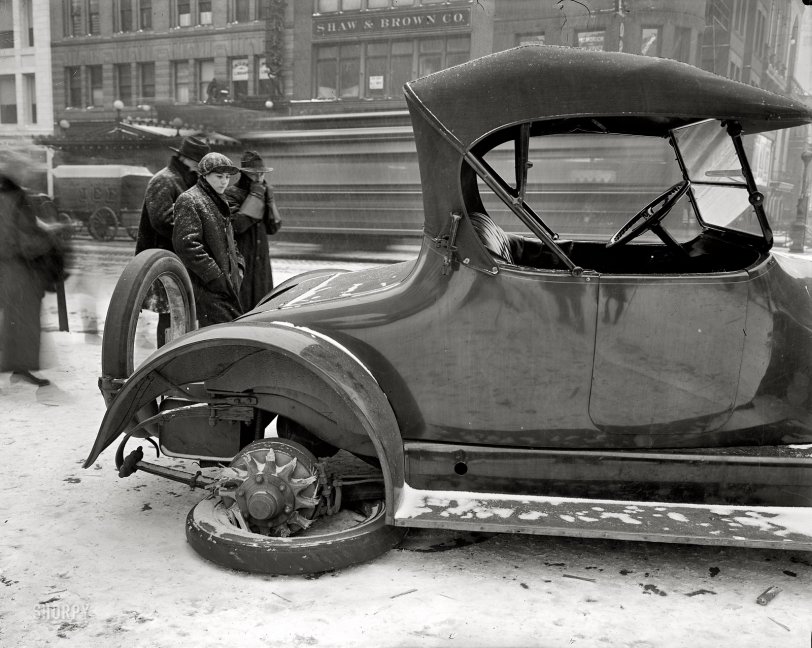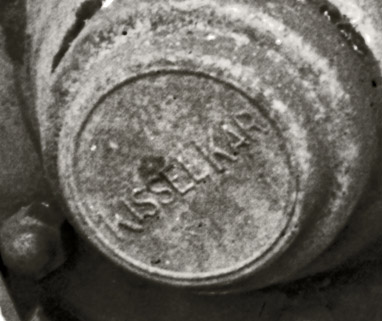


Framed or unframed, desk size to sofa size, printed by us in Arizona and Alabama since 2007. Explore now.
Shorpy is funded by you. Patreon contributors get an ad-free experience.
Learn more.

- Baldwin 62303
- Baldwin VO-1000
- Cold
- No expense spared
- Tough Guys
- Lost in Toyland
- And without gloves
- If I were a blindfolded time traveler
- Smoke Consumer Also Cooks
- Oh that stove!
- Possibly still there?
- What?!?
- $100 Reward
- Freeze Frame
- Texas Flyer wanted
- Just a Year Too Soon
- WWII -- Replacing men with women at the railroad crossing.
- Yes, Icing
- You kids drive me nuts!
- NOT An Easy Job
- I wonder
- Just add window boxes
- Icing Platform?
- Indiana Harbor Belt abides
- Freezing haze
- Corrections (for those who care)
- C&NW at Nelson
- Fallen Flags
- A dangerous job made worse
- Water Stop
Print Emporium
Hobbled: 1917

Washington, D.C., circa 1917. "Dr. W.J. Davis, disabled auto." Take two aspirin and call me in the morning. Harris & Ewing glass negative. View full size.
Open and Shut
Cars of the era were often open because steel sheet was made in relatively small pieces - pieces that could be handled by one person. In the early 1920s the American Rolling Mill Co. of Middletown OH invented continuous rolling in which rolled steel could be produced of virtually unlimited length. From this point on things changed in automobile design and a other areas such as the design and cost of appliances.
In the late 1920s cars many closed cars had large openings in the roof that were covered with canvas because the continuous rolled steel was limited in width. This limitation was overcome about 1930, and the modern auto was possible.
The American Rolling Mill Co became ARMCO Steel and is now AK Steel.
Charlie
(ret'd metallurgist and Patent Atty)
No Tread
I don't see any tread on the busted wheel, nor the spare. Slick as a whistle. Maybe tread would have keep him from skidding so fast and hard.
Kissel Kar indeed
Looks like stanton_square nailed it.

The Weather
I hope Dr. Davis found somewhere warm to wait while his car was towed. Judging by how high the men have pulled their coats up around their faces, I'd say it was pretty darn cold out there.
Spokes Person
First, thanks for this beautiful picture of a beautiful car.
The large hole in the body is to allow a mechanic to extract the pivot bolt from the forward leaf spring without disturbing the bodywork. (The forward end mirrors the rear end visible in the photo.)
Looking at the splinter pattern on the spokes, the car probably skidded sideways into the curb that broke the wheel off (clean break at the 12 o'clock spoke with bevel outboard).
Pinwheel splinters at the 9 and 3 o'clock position suggest that power was still being applied to the rear wheel. These spokes are in a "no load" position and would show torque damage more clearly.
Busted Spokes
The damage to the spokes was, clearly, cased by some sort of collision, probably with a curb. The spokes are broken rather cleanly. Not so evident is the fact that the left wheel is also AWOL. This car slid to the right, struck the curb and snapped the right wheel off, where it caught under the hub assembly. The left wheel suffered the same fate and is probably in the gutter. The car is far too new to have any termite damage to the spokes
Baby it's cold outside
Check out the old-style gauntlet gloves worn by the guy walking by the car.
Open cars
I'm seeing so many open cars on Shorpy that I ask: Did the inside (seats?) not start to rot eventually being exposed all the time? And then there's that hole in the body, left above the running board. Did it allow rainwater to flow out?
[Most cars back then were open, as were most horse-drawn conveyances. Seats and benches were upholstered with leather. The opening looks like a bolt hole. - Dave]
How'd-ee doo dat?
I suspect that he ran the wheel on the rim after he got a flat, just like I have seen drivers do today. If you run on a metal rim, you get a shower of sparks and a dented-up rim. If you run on a wood-spoke wheel without the tire long enough, you'd get splinters for spokes. Of course there are always the possible contributions of our wee winged friends in this matter. Because this wheel was made of wood, it could have alternatively had a termite problem. It doesn't look like doc was much on preventive maintenance for his car. After a couple really good bumps in the road...
Make and model
My question is, what kind of car is it? I can't make out the rear "hub cap." Looks sorta like a 1917 Cadillac from a cursory Google search.
To a T
Artillery wheels weren't just for "higher end cars" - the Model T had them, too. They were a holdover from the horse-drawn wagon days, and were soon to be replaced by stamped steel discs, or wire wheels (like on the Model A).
Wood is Good
Wooden wheels were used on virtually all cars of this era. Some of the high end and sporty cars used wire spokes, but wood was the norm.
Been there, done that
I'll bet he was cuttin' cookies in the snow. Then made an excuse that a horse ran in front of him.
Shaw & Brown
Were jewelers located at 1114 F Street NW. I found the location from a series of theater programs for Washington. Here is the link. If you look through it you will see ads for several other Washington businesses. http://digital.libraries.ou.edu/whc/nam/manuscripts/Cutlip_C_11_08.pdf
Nice touch
on the photo with the Ice truck in the background.
Kissel Kar?
There was once a time that cars were so few that individual sales were reported in the newspaper. Shaw & Brown Co. were gem dealers located at 1114 F Street.
Washington Post, Sep 10, 1916The Automobile World
...
The Henderson-Rowe Auto Company reports the following sales for the past week: ... Kissel Kars to ....Dr. W.J. Davis...
An old saw
"What, you want $20 to repair and replace that tire, the whole job won't take an hour? I'm a doctor and I don't earn $20 an hour."
Mechanic to Dr. Davis: "I know, That's one of the reasons I quit being a doctor."
Wooden Wheels
That's the downside of the wooden "Artillery Wheels" that were so popular on higher-end cars of that period.
Four forms of transportation
You see four forms of transportation, a wagon, a street car, walking and a vehicle. The one of those most likely to break down, has. Some things never change.
How'd he do that?
Anyone have any thoughts on how he managed to break off all the spokes so dramatically without apparent damage to the car?
I told you..
we shouldn't have tried to remove the wheel clamp.
Bald Tire Blues
It's impossible to determine what might have caused this accident, but that bald tire running on snow certainly didn't help. The spare doesn't have any tread on it either! Let's hope that the good doctor took better care of his patients than he did of his car. Meantime, a horse-drawn ice wagon moves peacefully by in the background... "Get a horse!"
Got a Spare?
Here's a case where a spare tire, even on a demountable rim, avails you nought. If only the entire wheel could be unbolted! We can only suppose the unlucky driver skidded on the icy road and plowed into the curb. However we get an unusual view of an interesting "3/4 elliptic"(?) rear spring system as well as a view of dual contracting-band rear brakes, one presumably for regular service and the other for the parking brake.
























On Shorpy:
Today’s Top 5